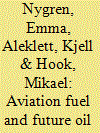|
|
|
Sort Order |
|
|
|
Items / Page
|
|
|
|
|
|
|
| Srl | Item |
| 1 |
ID:
091571


|
|
|
|
|
| Publication |
2009.
|
| Summary/Abstract |
Crude oil is a limited natural resource subject to depletion and several reports indicate that the world's crude oil production is close to the maximum level and that it will start to decrease after reaching this maximum. A post-Kyoto political agenda to reduce oil consumption will have the same effect on aviation fuel production as a natural decline in the crude oil production. On the other hand, it is predicted by the aviation industry that aviation traffic will keep on increasing.
|
|
|
|
|
|
|
|
|
|
|
|
|
|
|
|
| 2 |
ID:
126817


|
|
|
|
|
| Publication |
2014.
|
| Summary/Abstract |
Bottom-up models of oil production are continuously being used to guide investments and policymaking. Compared to simpler top-down models, bottom-up models have a number of advantages due to their modularity, flexibility and concreteness. The purposes of this paper is to identify the crucial modeling challenges, compare the different ways in which nine existing models handle them, assess the appropriateness of these models, and point to possibilities of further development. The conclusions are that the high level of detail in bottom-up models is of questionable value for predictive accuracy, but of great value for identifying areas of uncertainty and new research questions. There is a potential for improved qualitative insights through systematic sensitivity analysis. This potential is at present largely unrealized.
|
|
|
|
|
|
|
|
|
|
|
|
|
|
|
|
| 3 |
ID:
111392


|
|
|
|
|
| Publication |
2012.
|
| Summary/Abstract |
There is a lively debate between 'concerned' and 'unconcerned' analysts regarding the future availability and affordability of oil. We critically examine two interrelated and seemingly plausible arguments for an unconcerned view: (1) there is a growing amount of remaining reserves; (2) there is a large amount of oil with a relatively low average production cost. These statements are unconvincing on both theoretical and empirical grounds. Oil availability is about flows rather than stocks, and average cost is not relevant in the determination of price and output. We subsequently implement a bottom-up model of regional oil production with micro-foundations in both natural science and economics. An oil producer optimizes net present value under the constraints of reservoir dynamics, technological capacity and economic circumstances. Optimal production profiles for different reservoir drives and economic scenarios are derived. The field model is then combined with a discovery model of random sampling from a lognormal field size-frequency distribution. Regional discovery and production scenarios are generated. Our approach does not rely on the simple assumptions of top-down models such as the Hubbert curve - however it leads to the same qualitative result that production peaks when a substantial fraction of the recoverable resource remains in-ground.
|
|
|
|
|
|
|
|
|
|
|
|
|
|
|
|
| 4 |
ID:
101503


|
|
|
|
|
| Publication |
2010.
|
| Summary/Abstract |
The widening gap between EU gas production and consumption may require an 87% increase of import volumes between 2006 and 2030, and there are great uncertainties regarding the amounts of gas that can be expected from new suppliers. The potential of increased production from Norway and Algeria is limited; hence, Russia is likely to play a crucial part of meeting the anticipated growing gas demand of the EU. A field-by-field study of 83 giant gas fields shows that the major producing Russian gas fields are in decline, and by 2013 much larger supplies from the Yamal Peninsula and the Shtokman field will be needed in order to avoid a decline in production. Gas from fields in Eastern Siberia and the Far East will mainly be directed to the Asian and Pacific Rim markets, thereby limiting its relevance to the European and CIS markets. As a result, the maximum export increase to the European and CIS markets amounts only to about 45% for the period 2015-2030. The discourse surrounding the EU's dependence on Russian gas should thus not only be concerned with geopolitics, but also with the issue of resource limitations.
|
|
|
|
|
|
|
|
|
|
|
|
|
|
|
|
| 5 |
ID:
088224


|
|
|
|
|
| Publication |
2009.
|
| Summary/Abstract |
The most important contributors to the world's total oil production are the giant oil fields. Using a comprehensive database of giant oil field production, the average decline rates of the world's giant oil fields are estimated. Separating subclasses was necessary, since there are large differences between land and offshore fields, as well as between non-OPEC and OPEC fields. The evolution of decline rates over past decades includes the impact of new technologies and production techniques and clearly shows that the average decline rate for individual giant fields is increasing with time. These factors have significant implications for the future, since the most important world oil production base - giant fields - will decline more rapidly in the future, according to our findings. Our conclusion is that the world faces an increasing oil supply challenge, as the decline in existing production is not only high now but will be increasing in the future.
|
|
|
|
|
|
|
|
|
|
|
|
|
|
|
|
| 6 |
ID:
092811


|
|
|
|
|
| Publication |
2009.
|
| Summary/Abstract |
According to the long-term scenarios of the International Energy Agency (IEA) and the US Energy Information Administration (EIA), conventional oil production is expected to grow until at least 2030. EIA has published results from a resource-constrained production model which ostensibly supports such a scenario. The model is here described and analyzed in detail. However, it is shown that the model, although sound in principle, has been misapplied due to a confusion of resource categories. A correction of this methodological error reveals that EIA's scenario requires rather extreme and implausible assumptions regarding future global decline rates. This result puts into question the basis for the conclusion that global "peak oil" would not occur before 2030.
|
|
|
|
|
|
|
|
|
|
|
|
|
|
|
|
| 7 |
ID:
094289


|
|
|
|
|
| Publication |
2010.
|
| Summary/Abstract |
The assessment of future global oil production presented in the IEA's World Energy Outlook 2008 (WEO 2008) is divided into 6 fractions; four relate to crude oil, one to non-conventional oil, and the final fraction is natural-gas-liquids (NGL). Using the production parameter, depletion-rate-of-recoverable-resources, we have analyzed the four crude oil fractions and found that the 75 Mb/d of crude oil production forecast for year 2030 appears significantly overstated, and is more likely to be in the region of 55 Mb/d. Moreover, analysis of the other fractions strongly suggests lower than expected production levels. In total, our analysis points to a world oil supply in 2030 of 75 Mb/d, some 26 Mb/d lower than the IEA predicts.
The connection between economic growth and energy use is fundamental in the IEA's present modelling approach. Since our forecast sees little chance of a significant increase in global oil production, our findings suggest that the "policy makers, investors and end users" to whom WEO 2008 is addressed should rethink their future plans for economic growth. The fact that global oil production has very probably passed its maximum implies that we have reached the Peak of the Oil Age.
|
|
|
|
|
|
|
|
|
|
|
|
|
|
|
|
|
|
|
|
|